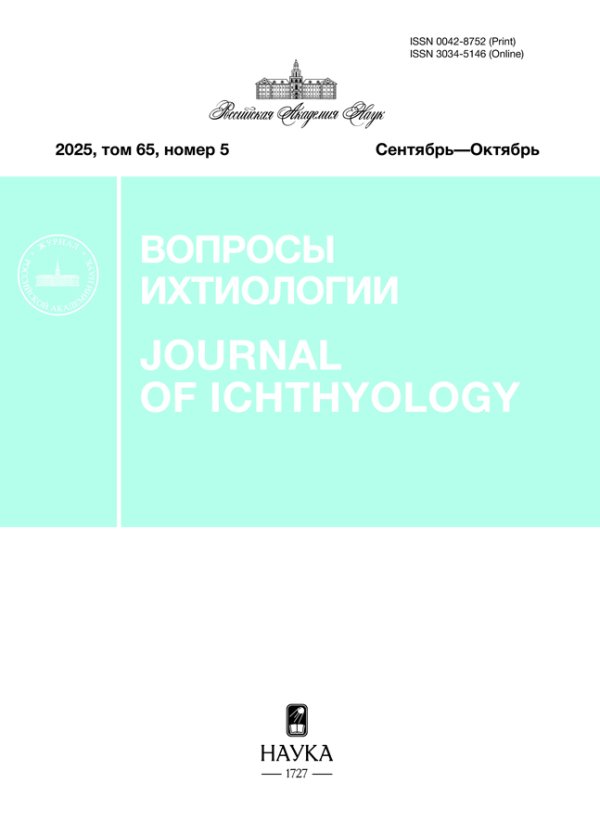A New Whalefish Species of the Genus Cetomimus (Cetomimidae) from the Tropical Part of the Central Atlantic
- Authors: Kobyliansky S.G.1, Gordeeva N.V.1,2, Mishin A.V.1
-
Affiliations:
- Shirshov Institute of Oceanology, Russian Academy of Sciences, Moscow, Russia
- Institute of General Genetics, Russian Academy of Sciences, Moscow, Russia
- Issue: Vol 63, No 3 (2023)
- Pages: 251-264
- Section: Articles
- URL: https://journals.rcsi.science/0042-8752/article/view/135182
- DOI: https://doi.org/10.31857/S0042875223030098
- EDN: https://elibrary.ru/BYIWGT
- ID: 135182
Cite item
Full Text
Abstract
A new species of bathypelagic whalefishes of the genus Cetomimus is described; its two specimens were caught over the central tropical part of the Mid-Atlantic Ridge at the layers of 1500–0 and 2680–0 m. The species is characterized by the presence of 31/2 gill arches (with a small slit behind the third gill arch) and cavernous tissue developed only around the anus and above the bases of the first to sixth rays of the anal fin; large pores in the lateral line canal, which are approximately as wide as this canal; the absence of large, valve-shaped triangular outgrowths along the margin of septa between pores in the posterior part of the lateral line; 42–48 vertebrae; and 20, 17–18, and 18 rays in the pectoral, dorsal, and anal fins, respectively; 17–18 pores in the lateral line canal between the upper margin of the gill cover and the end of the caudal peduncle, as well as by some other diagnostic features. The first molecular genetic data for the described species (mtDNA COX-1 sequences, or DNA barcodes) and analysis of interspecific divergence in the genus Cetomimus are given
About the authors
S. G. Kobyliansky
Shirshov Institute of Oceanology, Russian Academy of Sciences, Moscow, Russia
Email: kobylianskysg@gmail.com
Россия, Москва
N. V. Gordeeva
Shirshov Institute of Oceanology, Russian Academy of Sciences, Moscow, Russia; Institute of General Genetics, Russian Academy of Sciences, Moscow, Russia
Email: kobylianskysg@gmail.com
Россия, Москва; Россия, Москва
A. V. Mishin
Shirshov Institute of Oceanology, Russian Academy of Sciences, Moscow, Russia
Author for correspondence.
Email: kobylianskysg@gmail.com
Россия, Москва
References
- Кобылянский С.Г., Гордеева Н.В., Котляр А.Н. 2020. Новые нахождения редкого вида Rondeletia bicolor (Stephanoberycoidei) над Срединно-Атлантическим хребтом и некоторые вопросы филогении семейства Rondeletiidae // Вопр. ихтиологии. Т. 60. № 1. С. 16–25. https://doi.org/10.31857/S0042875220010099
- Abe T., Marumo R., Kawaguchi K. 1965. Description of a new cetomimid fish from Suruga Bay // Jpn. J. Ichthyol. V. 12. № 3–6. P. 57–63. https://doi.org/10.11369/jji1950.12.57
- Angulo A. 2015. Cetomimus gillii Goode & Bean, 1895 (Cetomimiformes: Cetomimidae): range extension and first record in the Tropical Eastern Pacific // Mar. Biodivers. Rec. V. 8. Article e22. https://doi.org/10.1017/S1755267215000019
- Bermingham E., McCafferty S., Martin A.P. 1997. Fish biogeography and molecular clocks: perspectives from the Panamanian isthmus // Molecular systematics of fishes. San Diego et al.: Acad. Press. P. 113–128. https://doi.org/10.1016/B978-012417540-2/50009-9
- Brauer A. 1906. Die Tiefsee-Fische. L. Systematischer Teil. Jena: G. Fischer, 432 p.
- Bucklin A., Ortman B.D., Jennings R.M. et al. 2010. A “Rosetta Stone” for metazoan zooplankton: DNA barcode analysis of species diversity of the Sargasso Sea (Northwest Atlantic Ocean) // Deep Sea Res. Part II. Top. Stud. Oceanogr. V. 57. № 24–26. P. 2234–2247. https://doi.org/10.1016/j.dsr2.2010.09.025
- Craddock J.E., Mead G.W. 1970. Midwater fishes from the Eastern South Pacific Ocean // Sci. Res. Southeast Pac. Exped. Contribut. Anton Bruun Rept. № 3. P. 1–46.
- Drummond A., Rambaut A. 2007. BEAST: Bayesian evolutionary analysis by sampling trees // BMC Evol. Biol. V. 7. Article 214. https://doi.org/10.1186/1471-2148-7-214
- Drummond A.J., Suchard M.A., Xie D. et al. 2012. Bayesian Phylogenetics with BEAUti and the BEAST v.1.7 // Mol. Biol. Evol. V. 29. № 8. P. 1969–1973. https://doi.org/10.1093/molbev/mss075
- Elz A., Schwenke P., Park L. 2012. NWFSC forensic marinefish voucher collection (https://www.ncbi.nlm.nih.gov/nuccore/JQ354000. Version 08/2022).
- Gilchrist J.D.F. 1922. Deep-sea fishes procured by the S.S. “Pickle” (Part I) // Report of the fisheries and marine biological survey, Union of South Africa. № 2. P. 41–79.
- Hanner R. 2009. Data Standards for BARCODE Records in INSDC (BRIs) // BARCODE Data Standards v.2.4. P. 1–4. (https://repository.si.edu/bitstream/handle/10088/96-518/BARCODE%20Data%20Standards%20v2.4.pdf?-sequence=1&isAllowed=y. Version 08/2022).
- Harry R.R. 1952. Deep-sea fishes of the Bermuda Oceanographic Expeditions, families Cetomimidae and Rondeletiidae // Zoologica. V. 37. Pt. 1. P. 55–72. https://doi.org/10.5962/p.184690
- Hebert P.D.N., Cywinska A., Ball S.L. et al. 2003. Biological identifications through DNA barcodes // Proc. R. Soc. Lond. B. V. 270. № 1512. P. 313–321. https://doi.org/10.1098/rspb.2002.2218
- Hebert P.D.N., Stoeckle M.Y.,Tyler S. et al. 2004. Identification of Birds through DNA Barcodes // PLoS Biol. V. 2. № 10. Article e312. P. 1657–1663. https://doi.org/10.1371/journal.pbio.0020312
- Hubert N., Hanner R., Holm E. et al. 2008. Identifying Canadian freshwater fishes through DNA barcodes // PLoS One. V. 3. № 6. Article e2490. https://doi.org/10.1371/journal.pone.0002490
- Johnson G.D., Paxton J.R., Sutton T.T. et al. 2009. Deep-sea mystery solved: astonishing larval transformations and extreme sexual dimorphism unite three fish families // Biol. Lett. V. 5. № 2. P. 235–239. https://doi.org/10.1098/rsbl.2008.0722
- Kenchington E.L., Baillie S.M., Kenchington T.J. et al. 2017. Barcoding Atlantic Canada’s mesopelagic and upper bathypelagic marine fishes // PLoS One. V. 12. № 9. Article e0185173. https://doi.org/10.1371/journal.pone.0185173
- Kimura M. 1980. A simple method for estimating evolutionary rate of base substitutions through comparative studies of nucleotide sequences // J. Mol. Evol. V. 16. № 2. P. 111–120. https://doi.org/10.1007/BF01731581
- Kozlov A.M., Darriba D., Flouri T. et al. 2019. RAxML-NG: A fast, scalable, and user-friendly tool for maximum likelihood phylogenetic inference // Bioinformatics. V. 35. № 21. P. 4453–4455. https://doi.org/10.1093/bioinformatics/btz305
- Maul G.E. 1969. On the genus Cetomimus (Cetomimidae) with the description of a new species // Bocagiana. № 18. P. 1–12
- Meier R., Shiyang K., Vaidya G. et al. 2006. DNA barcoding and taxonomy in Diptera: a tale of high intraspecific variability and low identification success // Syst. Biol. V. 55. № 5. P. 715–728. https://doi.org/10.1080/10635150600969864
- Miller M.A., Pfeiffer W., Schwartz T. 2010. Creating the CIPRES Science Gateway for inference of large phylogenetic trees // Gateway Computing Environments Workshop (GCE). New Orleans: IEEE. P. 1–8. https://doi.org/10.1109/GCE.2010.5676129
- Parr A.E. 1928. Deep-sea fishes of the order Iniomi from the waters around the Bahama and Bermuda Islands // Bull. Bingham Oceanogr. Coll. V. 3. № 3. P. 1–193.
- Paxton J.R. 1986. Family Cetomimidae // Fishes of the North-Eastern Atlantic and the Mediterranean. Paris: UNESCO. V. 2. P. 524–525.
- Paxton J.R. 1989. Synopsis of the whalefishes (family Cetomimidae) with descriptions of four new genera // Rec. Aust. Mus. V. 41. № 2. P. 135–206. https://doi.org/10.3853/j.0067-1975.41.1989.141
- Paxton J.R., Bray D.J. 1986. Order Cetomimiformes // Smiths’ Sea fishes. Berlin: Springer. P. 433–434.
- Paxton J.R., Trnski T., Johnson G.D. 2016. Cetomimidae // The living marine resources of the Eastern Central Atlantic. Rome: FAO. V. 3. Pt. 1. P. 2174–2182.
- Pereira L.H., Hanner R., Foresti F. et al. 2013. Can DNA barcoding accurately discriminate megadiverse Neotropical freshwater fish fauna? // BMC Genet. V. 14. Article 20. https://doi.org/10.1186/1471-2156-14-20
- Posada D. 2008. jModelTest: phylogenetic model averaging // Mol. Biol. Evol. V. 25. № 7. P. 1253–1256. https://doi.org/10.1093/molbev/msn083
- Puillandre N., Lambert A., S. Brouillet S. et al. 2012. ABGD, Automatic Barcode Gap Discovery for primaryspecies delimitation // Mol. Ecol. V. 21. № 8. P. 1864–1877. https://doi.org/10.1111/j.1365-294X.2011.05239.x
- Rambaut A., Drummond A.J., Xie D. et al. 2018. Posterior summarization in Bayesian phylogenetics using Tracer 1.7 // Systematic Biol. V. 67. № 5. P. 907–904. https://doi.org/10.1093/sysbio/syy032
- Sahu S.K., Singh R., Kathiresan K. 2016. Multi-gene phylogenetic analysis reveals the multiple origin and evolution of mangrove physiological traits through exaptation // Estuar. Coast. Shelf. Sci. V. 183. Pt. A. P. 41–51. https://doi.org/10.1016/j.ecss.2016.10.021
- Tolley S.G., Gartner J.V., Lancraft T.M. 1989. Whalefishes (Beryciformes: Cetomimoidei) of the gulf of Mexico // Bull. Mar. Sci. V. 45. № 3. P. 671–677.
- Villesen P. 2007. FaBox: an online toolbox for FASTA sequences // Mol. Ecol. Notes. V. 7. № 6. P. 965–968. https://doi.org/10.1111/j.1471-8286.2007.01821.x
- Ward R.D. 2009. DNA barcode divergence among species and genera of birds and fishes // Mol. Ecol. Res. V. 9. № 4. P. 1077–1085. https://doi.org/10.1111/j.1755-0998.2009.02541.x
- Ward R.D., Zemlak T.S., Innes B.H. et al. 2005. DNA barcoding Australia’s fish species // Philos. Trans. R. Soc. B. V. 360. № 1462. P. 1847–1857. https://doi.org/10.1098/rstb.2005.1716
- Zhang J., Kapli P., Pavlidis P. et al. 2013. A General species delimitation method with applications to phylogenetic placements // Bioinformatics. V. 29. № 22. P. 2869–2876. https://doi.org/10.1093/bioinformatics/btt499
Supplementary files

















